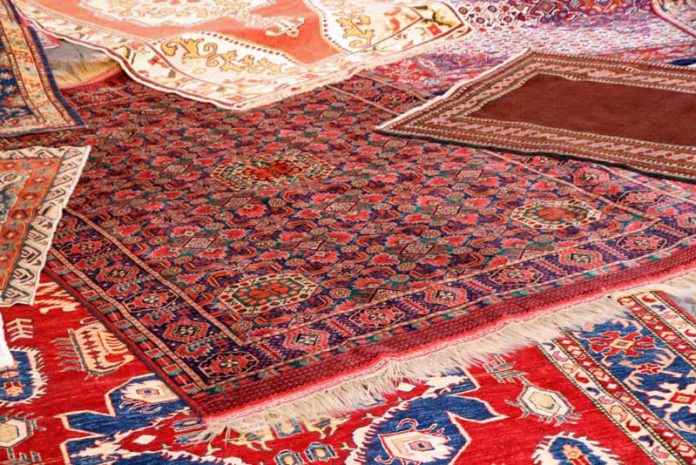Whether you want to create a more aesthetic living room or want to make a space feel more homely and inviting, using rugs and carpets is a must.
But did you know that while some carpets are just decorative, others are priceless historical artefacts?
Learn about some of the most famous carpets worldwide below.
Pazyryk carpet
The oldest carpet known to man is the Pazyryk carpet. Experts estimate that it is more than a couple of thousand years old and essentially a pile carpet rug. It was first found in a Siberian Burial Mound of a Scythian noble in 1949, where it was preserved in ice for all this time. It has since been transported for preservation in the Hermitage, St. Petersburg.
What’s even more interesting is that the burial mound was robbed in the past and left open. The items of lesser value, such as the carpet, were left there. The robbers didn’t bother to cover the mound, which led to water seeping inside and covering the Pazyryk carpet. It froze in the winter, and that’s how the precious item has been preserved until now.
The creators of the carpet to this day are unknown but are believed to be possibly tribes of Central Asia. The Pazyryk has a beautiful ribbon pattern in its centre and utilises the so-called Ghiordes knot (or Turkish knot). The carpet is also completely made of wool.
Another interesting fact about the elks depicted on it is that they show the inwards of the animals with almost exact clinical precision.
The Ardabil
The Ardabil are a pair of Iranian carpets in the Victoria and Albert Museum collection in London and the Los Angeles County Museum of Art. They’re perhaps the most famous carpets in the world, known for their vast size (38 feet by 18 feet wide), unique pattern and style.
Both carpets have an inscription by a Persian poet and a signature. The carpets were finished in the mid-16th century and are considered some of the finest carpet creations from the classical Persian school.
In 1890 they were sold to a British carpet broker who restored one of the carpets from the other and then sold one on to the Victoria and Albert Museum and the second smaller, borderless carpet to agents of King Farouk of Egypt before being donated to Exposition Park.
Persian Carpets
Persian Carpets are well known for being an essential part of Persian art and culture. Carpet weaving dates back to ancient Persia, and weavers from other countries also copy designs.
Carpets are divided into three groups depending on their size and weave. Every part of the carpet is traditionally handmade from natural materials. Wool, silk and even metal thread have been crafted into the layout and design.
Another world-famous example of a Persian carpet is The Rothschild Small Silk Medallion Carpet. It was made in the 16th century by the court studio of the Shah. Despite being ancient, the carpet is still in fantastic condition. The art historian Phillip Jodidio commented that it must have been kept in darkness and almost never touched.
Nowadays, people can also buy a contemporary version of the Persian carpet for their homes. They make an excellent addition if your place has hardwood or laminate flooring. Persian rugs provide a luxurious feel to any home and are very durable, which makes them an ideal choice if you have kids or pets.
Thankfully, they can be easily cleaned. However, sometimes it makes more sense to get experienced carpet cleaners to do the task, as it provides excellent results and saves time.
Armenian carpets
Due to the fragility of Armenian carpets, almost none of the early ones survived until the late medieval period. Traditionally the carpets were used to cover floors but were also hung on walls and used as covers for beds and chairs.
Armenian weaving was complex and practised diligently. Furthermore, inscribed with Armenian religious text by Norayr de Byzance in 1908, the famous Gohar Carpet, like The Rothschild Small Silk Medallion Carpet, is still in excellent condition despite its age. It was created for the woman’s church and was most likely only used in ceremonies.
Nowadays, the ancient art of creating Armenian carpets is still preserved by the people of Armenia and Nagorno-Karabakh, using the same ancient weaving techniques. Given the country’s long and often tumultuous history, that is truly a remarkable feat.
Due to their delicate design, if you are fortunate enough to own one, you must be very careful when protecting your Armenian carpet, for the carpet patch repair technique wouldn’t work here. So, keep food and drinks away from it, and train your pets to keep them off the carpet.
Turkish carpets
Turkish carpets are renowned as some of the world’s most established handcrafted works of art.
The oldest record of these flat woven carpets dates back to around 7000 BC. They are always handmade of wool and cotton and sometimes of silk. Used to decorate sofas, beds and table tops as well as for prayers and ceremonial services, these carpets were traditionally woven by young girls who learned the skills at an early age and women.
Ushak carpets or Anatolian rugs are oriental and have been called “masterpieces”. Each individual carpet has a similar pattern and is made of silk and luminous wool. These highly regarded works of art are acclaimed throughout the world.
If you’re lucky enough to own a valuable and precious carpet, make sure to take care of it – find out how to maintain and clean it yourself or utilise the services of professional carpet cleaners. If an accidental leak happens, you also need to know how to dry your wet carpet quickly.
Conclusion
The history of carpets and rugs is long and complex, dating millennia.
The human need for beauty and comfort has employed many craftsmen’s talents to create truly beautiful and unique pieces, each marked by the culture in which they were produced.
And nothing can make us more appreciative of the skill it takes to create such beauty than by learning more about the history of world-renowned carpets.








































